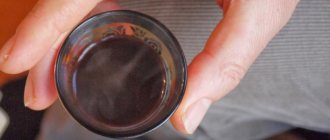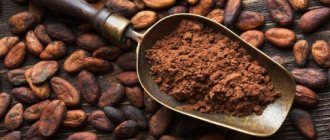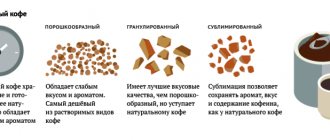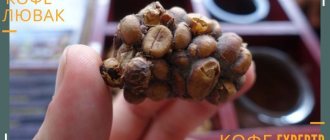Coffee contains a huge number of different substances. Among products of natural origin, coffee beans remain the record holders in terms of the number of constituent components. They contain not only organic, but also inorganic components. It is thanks to this diversity that this popular drink is able to have such a powerful effect on the human body. It is curious that it affects almost all organs and tissues. When you drink another cup of aromatic coffee, its composition directly affects the reaction of your body. This is why it is so important to know what coffee beans are made of and what happens to these substances during roasting. Let us warn you right away that the chemical composition of coffee is very complex and confusing. According to the most conservative estimates of scientists, coffee contains about 1200 substances. We will take a detailed look at the composition of coffee beans, their nutritional value, as well as their effect on the human body.
Coffee growing areas in the past
Until the 14th century, coffee grew wild in Ethiopia. The coffee tree was then brought to the Arabian Peninsula. In the late 16th century, European traders began purchasing coffee from Arab ports and bringing it to Europe in the 1600s. According to legend, in the mid-17th century, a Muslim pilgrim secretly exported coffee beans to South India. From there, at the end of the 17th century, Dutch traders secretly exported the coffee tree to Java and Sumatra. This marked the end of the Arab monopoly on coffee cultivation.
Then, in 1706, Dutch colonists sent a seedling of a coffee tree to the botanical gardens of Amsterdam, and from this tree the cultivation of the plant began in the colonies of the New World. A few years later, the French king received a tree seedling as a gift from the Dutch, and soon the French exported mocha varieties from Yemen to the island. Bourbon (now Reunion, near the island of Madagascar). This is how the history of the famous Arabica variety called “bourbon” began.
In 1721, plantations were established in Guiana and Martinique. In 1727 - in Brazil, in 1730 - in Jamaica (the beginning of the famous Blue Mountain variety), 1748 - in Cuba, 1760 - in Guatemala, 1779 - in Costa Rica, and by the beginning of the 19th century the Earth's coffee belt was closed. In just a few centuries, coffee has become popular in both hemispheres, being a good source of income.
Chlorogenic acids
Phenolic compounds in coffee beans are represented by chlorogenic acids. Esters of cinnamic acids reach the highest concentrations. Esters of caffeic and ferulic acids are also found. These compounds are responsible for the acidity of coffee.
The content of these compounds in grain reaches 10%. Their content decreases during roasting as they are destroyed by temperature. Chlorogenic acids give beans their dark color after roasting. The greater their concentration, the darker the color.
Types of coffee
In nature, there are about 70 species of coffee trees - from dwarf shrubs to 10-meter giants.
There are two main botanical types of coffee trees and, accordingly, beans obtained from the fruits of these trees: Arabica and Robusta, which is sometimes called Congolese coffee. According to various estimates, these two types account for up to 98% of the coffee produced. This volume is divided in the ratio of 70% - Arabica, 30% - Robusta. The remaining 30 (according to other estimates - 70) species account for only 2% of world coffee production.
The most common variety of coffee, Arabica, grows at an altitude of 600 to 2000 meters above sea level. Beautifully shaped beans usually have an oblong shape, a smooth surface, a slightly curved “S”-shaped line, in which, after light roasting, unburned particles of coffee berries usually remain.
The Robusta species is fast-growing and more pest-resistant than Arabica, and grows from approximately 0 to 600 m above sea level, primarily in tropical areas of Africa, India and Indonesia. The grains have a round shape, color - from light brown to grayish-green.
Robusta is generally considered a less refined coffee in terms of aroma. At the same time, it contains more caffeine, and is also often used in espresso blends, which allows for better coffee crema and reduces the cost of the mixture.
Other varieties, such as Liberica and Excelsa, are not of industrial importance. However, some varieties, for example, the Kopi Luwak or Cape Alameed variety grown in Africa, are the most expensive coffee (about 750 rubles per cup), since for proper preparation they must go through the food chain, including the gastrointestinal tract of musanga, or Asian palm civet (Paradoxurus hermaphroditus) is a small animal of the civet family. Without the last link, the taste and aroma of this coffee are very mediocre.
Recently, a cheaper (10 times) analogue of Kopi Luwak, “Monkey Coffee”, has appeared, from Taiwanese plantations on the slopes of the Formosan Mountains, with the same complex chain of processing raw beans.
What is the difference between Yellow, Red and Black Honey?
So, after getting acquainted with the term “hani”, it’s time to study the different types of this process. This description is rarely found on coffee packaging, but producers and exporters use terms such as white honey, yellow honey, gold, red and black honey.
White and yellow honey – when processing coffee cherries after mechanical cleaning, a small amount of gluten remains on the bean.
Golden, red and black honey - in this case, on the contrary, when processing the coffee berry after mechanical cleaning, a larger amount of gluten remains. As a result, the coffee is fuller-bodied.
Is it possible to formulate these processes in even more detail? In fact yes. But this processing method can be affected by factors such as humidity, temperature, sugar oxidation - all of which do not allow for an accurate description. Roughly speaking, the Hani method can be divided as follows:
White and Yellow Honey
Processed white honey coffee is mechanically washed and as a result, a minimal amount of gluten remains on the beans. Yellow honey – semi-washed with a slightly larger layer of gluten.
However, these terms will differ from farm to farm. And no matter what the processing process is called, it is always better to find out exactly how the coffee was processed before buying or selling coffee. To avoid misunderstandings on all sides!
White honey, complex and unique. ©Caffe Pecora
Gold, Red and Black Honey
What distinguishes these three processes is the amount of light and the time for which the grain is left to dry. With high humidity and a slow processing process, black honey . A little less moisture and we get red honey , even less moisture - golden .
Golden Hani is dried in warm, sunny weather with low humidity. For red honey , the process takes place in the shade to slow down the drying process. This allows you to increase the amount of moisture that has such a strong effect on the grain. And to get black honey , it takes even more time, and the drying process takes place with even less light.
Black honey processed coffee has a rich taste, aroma and is more expensive. ©Gold Mountain Coffee Growers
Story
Coffee shop in Palestine, 1900
According to the most widespread legend, the tonic properties of coffee were discovered by an Ethiopian shepherd named Kaldi, who noticed that his goats, having eaten the dense leaves and dark red fruits of the coffee tree during the day, began to behave excitedly at night for no apparent reason. He told the abbot of the monastery about this strange incident, and he decided to try the effect of the unusual grains on himself.
The abbot was amazed by the power of the drink and, in order to maintain the vigor of the monks who fell asleep during night prayers, ordered them to drink this decoction. Subsequently, the monks learned to roast and grind grains. The resulting drink relieved fatigue and gave fresh strength.
The discovery of coffee dates back to approximately 850 AD. e., but its full recognition came many centuries later. Initially, not a decoction of roasted beans, but directly raw coffee berries were used as a tonic. A little later, in Yemen they began to prepare a drink from the ripe dried pulp of the coffee fruit, obtaining a drink - “geshir” (aka kishr) - the so-called “white Yemeni coffee”[1]. The Ethiopians were finally expelled from the Arabian Peninsula in the 11th century. During their reign, the Arabs adopted much of the original and rich culture of the Ethiopians, including the habit of drinking coffee. In the beginning, the Arabs prepared it in a way that was far from modern. They crushed coffee beans and mixed them with animal fat and milk. From the resulting mass they made balls, which they took with them on the road as a general strengthening agent.
Only in the 12th century did they begin to prepare a drink from raw coffee beans, and centuries later they began to pick fruits from coffee trees, dry the beans, fry and grind them, and pour hot water into the resulting powder. The Arabs added various spices to it, such as ginger and cinnamon. The drink was also mixed with milk.
- In 1475, the first specialized coffee shop, Kiva Khan, was opened in Constantinople. In Istanbul, the first public coffee house was opened in 1564[2].
- The wide spread of coffee as a popular drink in Europe began in Vienna in 1683 and is associated with the name of the Ukrainian merchant (former Cossack) Yuri-Franz Kulchitsky[3]. At the decisive moment of the siege of Vienna by the Turks in the same 1683, Yuri-Franz Kulchitsky, dressed in Turkish clothes, passed through enemy cordons and led Allied troops to the aid of the besieged city. In 1684 he received the title of honorary citizen of Vienna. As a reward, he asked to give him 300 bags of coffee beans captured from the Turks. In fact, Yuri Kulchitsky became one of the first unrecognized classics of advertising. He personally promoted coffee, carrying it through the city streets in Turkish clothes, invented a bagel, which the Viennese ate in revenge against the Turks, and in 1684 in Vienna he published a book of his memoirs, which immediately became a bestseller in Europe. On August 13, 1684, Kulczycki opened the first coffee shop in Vienna[3]. He adapted Turkish coffee to European tastes, adding sugar and milk and creating the famous “Viennese coffee” - a drink that conquered all of Europe. A couple of years later, the Armenian Prokop opened the first coffee shop in Paris, and soon Europe was swept by a real coffee boom.
- The great composer Johann Sebastian Bach wrote the comic “Coffee Cantata” based on the poems of the German poet Picander, which was first performed in 1734.
- Peter I introduced the custom of drinking coffee to Russia.
- In the 18th century, Europeans introduced coffee seedlings to many tropical countries around the world. Currently, most coffee is produced in Brazil, Colombia, Vietnam, Indonesia, Mexico, India and Ethiopia.
Main coffee growing areas
- In 1899, Swiss chemist Max Morgenthaler created instant coffee. Instant coffee came into use in the 40s of the XX century.
How much caffeine is in different products
Coffee beans are the main and best known source of caffeine. It was in coffee that it was first discovered. Tea, carbonated drinks, sports nutrition, cocoa, chocolate - this is not a complete list of products that contain caffeine, in varying quantities. Accordingly, it is used by both adults and children.
With reasonable consumption, caffeine cannot harm even a child or a pregnant woman. For an adult, the daily norm is 300 mg, for pregnant women - 200 mg, and for a child 2.5 mg per 1 kg of weight. The calculation takes into account the volume obtained from all products consumed per day.
| Coffee (depending on the type and method of preparation) – 100 ml | 80-170 mg |
| Decaffeinated coffee – 100 ml | 2-3 mg |
| Black tea – 100 ml | 20-65 mg |
| Green tea – 100 ml | 15-30 mg |
| Instant cocoa – 100 ml | 2-3 mg |
| Natural cocoa – 100 ml | 5-10 mg |
| Dark chocolate – 100 g | 70-90 mg |
| Coca-Cola - 100 ml | 10.4 mg |
| Milk chocolate – 100 g | 10-60 mg |
| Instant coffee – 100 ml | 60-100 mg |
| Energy drinks – 100 ml | 20-35 mg |
| Painkillers - 1 tablet | 15-115 mg |
Growing
Young seedling
First, specially bred seeds are planted in a nursery where the required amount of sunlight and shade is provided. After about six months, the seedlings are transplanted into a field whose soil is prepared for them with the help of fertilizers. Coffee seedlings are planted in rows, the distance between which is made taking into account the care of the seedlings and the soil, as well as for harvesting.
Plants bear fruit only with year-round care, which includes weeding and regular treatment of trees with fungicides and insecticides to protect them from pests and diseases, such as bean borer or coffee rust.
Arabica flowers
A young plant begins to bear fruit after at least two years. It is better to pick coffee by hand, picking only ripe berries one by one; This is exactly what is done in Colombia, Costa Rica and other countries, where companies specifically hire seasonal workers.
Fermentation
Hand-picked berries are usually processed wet. They are placed in a grinding machine, which removes most of the pulp from the seeds. The seeds are then placed in tanks for one to three days, where, under the action of naturally occurring enzymes, the remaining pulp is decomposed through the process of fermentation. After this, the seeds are washed, removing the last remnants of pulp. Some of them are dried under the sun on concrete terraces or drying tables, and some are passed through hot air dryers. Following this, the layers of dry skin covering the seeds, which consists of parchment and silvery shells, are mechanically removed. Fermentation, which is carried out by wet processing, along with the use of only fully ripened berries, allows us to obtain smooth coffee of excellent quality.
In Brazil, a major coffee-producing country, the harvesting method most commonly used on plantations is known as derriça. Coffee is harvested by hand, removing every single berry from the branches, regardless of their degree of ripeness. Recently, some plantations began to switch to mechanized and semi-mechanized harvesting methods to improve product quality and increase labor productivity. One involves using a hand-held pneumatic tool to shake the branches, causing the berries to fall to the ground.
Fallen fruits are raked and sifted either manually or mechanically to remove leaves, dirt and sticks. The coffee cherries are then placed in large 60-liter baskets. The sifted berries are washed in a concrete trough or in a machine specially designed for this purpose. During washing, ripe fruits are separated from old dry ones that have begun to rot.
Drying
The washed coffee is laid out on a large concrete terrace to dry in the sun for 15-20 days. At this time, in order for the grains to dry properly, they are turned over approximately every 20 minutes. Sometimes, to make them dry faster, mechanical dryers are used. It is necessary to monitor the moisture content of the grains, otherwise they may dry out, causing them to become brittle and begin to break, and because of this their value will decrease. When the ideal moisture content is reached—between 11 and 12 percent—the grains are mechanically hulled. It is then put into bags and sent to factories where it is classified and further processed.
How coffee changes your mind
Finally, a very interesting fact. Australian scientists from the University of Queensland have found that a person who has consumed a certain dose of caffeine is more easily susceptible to psychological influence .
This conclusion was made based on experiment. 140 volunteers took part in it. Each of the subjects was asked in advance about their position on a specific topic. They divided everyone into two groups: the first group was asked to drink several cups of coffee, while the second group was left without a drink.
Counter-arguments against the participants' positions were then provided. And the most interesting thing: those who did not drink the coffee drink did not change their opinion. Lovers of the strong drink were inclined to change their point of view , and some of them changed their minds after listening to the arguments.
Scientists characterize these actions by the fact that a person who drinks coffee experiences a kind of euphoria, and therefore is more relaxed in his behavior and judgment.
Next time at negotiations, I will probably refuse a cup of aromatic coffee. And I advise you 
( 9 votes, overall rating: 4.78 out of 5)











